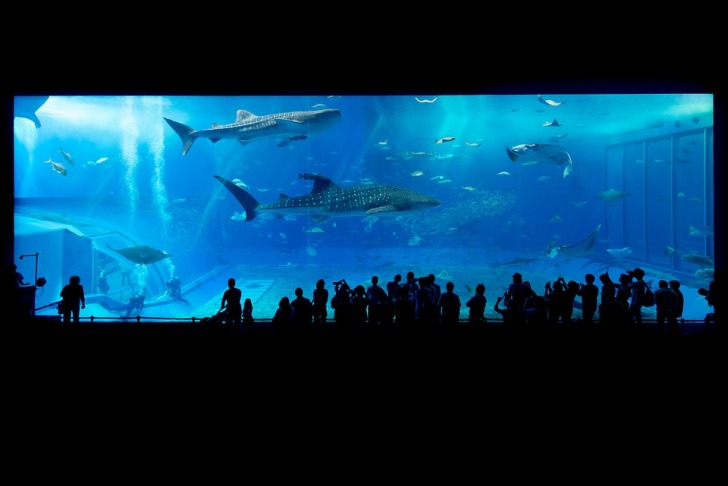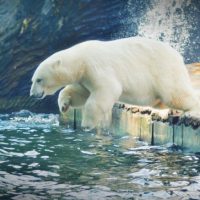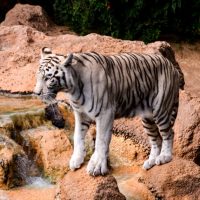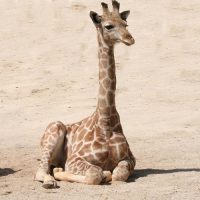Australia is a land of vast and diverse wildlife, and its zoos and aquariums are a reflection of that diversity.
Whether you’re interested in native Australian animals, exotic species from around the world, or marine life, there’s something for everyone at these top-rated zoos and aquariums.
From the iconic koalas and kangaroos of the mainland to the unique marine life of the Great Barrier Reef, these zoos and aquariums offer visitors a chance to experience the wonder and beauty of the natural world.
Contents
- 13 Best Zoos and Aquariums in Australia
- 13 Best Zoos & Aquariums in Australia – Summary Table
- Why Visit Australia’s Aquariums and Zoos?
- Australia Safety Overview
- Frequently Asked Questions
- What types of animals can I expect to see at Australian zoos and aquariums?
- Are there any zoos and aquariums in Australia that offer the opportunity to interact with animals?
- Are there any zoos and aquariums in Australia that offer overnight stays?
- Are there any zoos and aquariums in Australia that are wheelchair-accessible?
- Are Australian zoos and aquariums involved in conservation efforts?
- Are there any zoos and aquariums in Australia that focus on marine life?
13 Best Zoos and Aquariums in Australia
Taronga Zoo, Sydney
Taronga Zoo is one of the most popular tourist attractions in Australia, and for good reason.
The zoo is home to over 4,000 animals from over 350 species, including native Australian animals such as koalas, kangaroos, and Tasmanian devils, as well as exotic animals like elephants, giraffes, and Sumatran tigers.
Visitors can take a ferry to the zoo and enjoy spectacular views of Sydney Harbour while exploring the zoo’s many exhibits.
Melbourne Zoo: Melbourne Zoo is another popular destination for visitors to Australia.
The zoo is home to over 320 species of animals, including native Australian animals such as kangaroos, wallabies, and Tasmanian devils, as well as exotic animals like lions, tigers, and gorillas.
The zoo also has a large variety of bird species, including parrots and emus, and a wide range of reptiles and amphibians.
Perth Zoo
Perth Zoo is another great destination for animal lovers and is home to over 1,200 animals from over 162 species.
The zoo has a wide range of native Australian animals, including kangaroos, koalas, and wombats, as well as exotic animals like elephants, rhinoceroses, and chimpanzees.
The zoo also has a large variety of bird species, including parrots and emus, and a wide range of reptiles and amphibians.
Adelaide Zoo
Adelaide Zoo is a fantastic place to visit while in Australia.
It is home to over 300 different species of animals.
The zoo features a diverse collection of native Australian animals such as kangaroos, koalas, and Tasmanian devils, as well as exotic animals like lions, tigers, and gorillas.
In addition to that, it also has a large variety of bird species such as parrots and emus, and a wide range of reptiles and amphibians.
Australia Zoo
Australia Zoo is another popular destination for animal lovers and is home to over 1,200 animals from over 100 species.
The zoo has a wide range of native Australian animals, including kangaroos, koalas, and crocodiles, as well as exotic animals like tigers and elephants.
The zoo is also home to the Steve Irwin Wildlife Reserve, which is dedicated to the conservation of Australian wildlife.
Sea World, Gold Coast
SeaWorld is one of Australia’s largest marine parks and is home to a large variety of marine animals, including dolphins, seals, sharks, and rays.
The park also has a large variety of bird species and a large reptile collection.
Visitors can enjoy the park’s many shows and exhibits, as well as the opportunity to swim with dolphins or dive with sharks.
Aquarium of Western Australia
The Aquarium of Western Australia is another great destination for marine life enthusiasts and is home to over 30,000 marine animals from over 400 species.
The aquarium has a wide range of marine animals, including sharks, rays, and a large variety of fish species, as well as a large variety of bird species and a large reptile collection.
Cairns Aquarium
Cairns Aquarium is home to an impressive collection of marine life, with over 15,000 animals from over 350 species on display, including sharks, rays, and a wide variety of fish species.
The aquarium also boasts a significant collection of bird species, as well as a large variety of reptiles.
Sydney Aquarium
Sydney Aquarium is home to over 700 species of marine animals, including sharks, rays, and a large variety of fish species.
The aquarium also has a large variety of bird species and a large reptile collection.
Great Barrier Reef Aquarium
The Great Barrier Reef Aquarium showcases a vast array of marine life, with more than 1,500 animals from over 400 species on display, such as sharks, rays, and a diverse variety of fish.
Additionally, the aquarium also boasts a broad range of bird species and a large collection of reptiles.
National Aquatic Centre
National Aquatic Centre is located in Canberra and is home to over 5,000 marine animals from over 400 species.
The center has a wide range of marine animals, including sharks, rays, and a large variety of fish species, as well as a large variety of bird species and a large reptile collection.
Visitors can enjoy the center’s many exhibits and educational programs.
Reef HQ Aquarium
Reef HQ Aquarium, located in Townsville, boasts a collection of over 10,000 marine animals from more than 400 species.
The aquarium is the largest living coral reef aquarium in the world and offers visitors the opportunity to experience the diversity and beauty of the Great Barrier Reef without leaving the facility.
The aquarium features a wide range of marine life, including sharks, rays, and a diverse variety of fish species, as well as a broad collection of bird species and a large variety of reptiles.
Furthermore, Reef HQ Aquarium is also a research and education center that focuses on the conservation of the Great Barrier Reef.
Sydney Tower Eye
Sydney Tower Eye is a popular tourist attraction in Sydney and is home to an aquarium located at the base of the tower.
The aquarium is home to over 15,000 marine animals from over 400 species and has a wide range of marine animals, including sharks, rays, and a large variety of fish species, as well as a large variety of bird species and a large reptile collection.
Oceanworld Manly
Oceanworld Manly is a marine park located in Sydney and is home to over 10,000 marine animals from over 400 species.
The park has a wide range of marine animals, including sharks, rays, and a large variety of fish species, as well as a large variety of bird species and a large reptile collection.
Visitors can enjoy the park’s many shows and exhibits, as well as the opportunity to swim with dolphins or dive with sharks.
13 Best Zoos & Aquariums in Australia – Summary Table
| Zoos and Aquariums | Address |
|---|---|
| Taronga Zoo, Sydney | Bradleys Head Rd, Mosman NSW 2088, Australia |
| Perth Zoo | 20 Labouchere Rd, South Perth WA 6151, Australia |
| Adelaide Zoo | Frome Rd, Adelaide SA 5000, Australia |
| Australia Zoo | 1638 Steve Irwin Way, Beerwah QLD 4519, Australia |
| Sea World, Gold Coast | Seaworld Dr, Main Beach QLD 4217, Australia |
| Aquarium of Western Australia | 91 Southside Dr, Hillarys WA 6025, Australia |
| Cairns Aquarium | 5 Florence St, Cairns City QLD 4870, Australia |
| Sydney Aquarium | 1-5 Wheat Rd, Sydney NSW 2000, Australia |
| Great Barrier Reef Aquarium | 2-68 Flinders Street, Townsville |
| National Aquatic Centre | Olympic Blvd, Sydney Olympic Park NSW 2127, Australia |
| Reef HQ Aquarium | 2/36 Kelleher Pl, Townsville QLD 4810, Australia |
| Sydney Tower Eye | Westfield Sydney, Level 5/108 Market St, Sydney NSW 2000, Australia |
| Oceanworld Manly | West Esplanade, Manly NSW 2095, Australia |
Why Visit Australia’s Aquariums and Zoos?
Australia is home to some of the world’s most renowned zoos and aquariums, with many of them offering visitors a unique and immersive experience.
Some of the reasons why Australia’s zoos and aquariums are considered great include:
- Diverse animal collection: Australia is home to a wide variety of unique and exotic animals, including kangaroos, koalas, platypuses, and Tasmanian devils, which can be found in many of the country’s zoos and aquariums. These institutions work to conserve and protect these species, while also providing visitors with the opportunity to learn about and observe them up close.
- Innovative habitats: Many of Australia’s zoos and aquariums have invested in creating naturalistic habitats that closely mimic the animals’ natural environments. This allows visitors to see the animals in a more authentic setting, and also provides the animals with a more stimulating and comfortable environment.
- Conservation and education: Many of Australia’s zoos and aquariums are heavily focused on conservation and education. They work to protect endangered species and educate visitors about the importance of conservation and how they can help.
- Interactive experiences: Australia’s zoos and aquariums offer a wide range of interactive experiences for visitors, such as animal encounters, behind-the-scenes tours, and even sleepovers. These experiences allow visitors to get up close and personal with the animals and learn more about them in a unique and exciting way.
- Great facilities and amenities: Australia’s zoos and aquariums are known for having great facilities and amenities, such as well-maintained grounds, clean restrooms, and plenty of seating and shade. This makes for a comfortable and enjoyable visit for all ages.
Australia Safety Overview
READ THE FULL REPORT: Australia Safety Review
Safety Index:
- OVERALL RISK: LOW
- TRANSPORT & TAXIS RISK: LOW
- PICKPOCKETS RISK: LOW
- NATURAL DISASTERS RISK: MEDIUM
- MUGGING RISK: LOW
- TERRORISM RISK: LOW
- SCAMS RISK: LOW
- WOMEN TRAVELERS RISK: LOW
Frequently Asked Questions
What types of animals can I expect to see at Australian zoos and aquariums?
Australian zoos and aquariums have a wide variety of animals on display, including native Australian animals such as koalas, kangaroos, and Tasmanian devils, as well as exotic animals from around the world such as elephants, lions, and giraffes.
Many zoos and aquariums also have a variety of bird species and reptiles, and some have marine life such as sharks, rays, and a large variety of fish species.
Are there any zoos and aquariums in Australia that offer the opportunity to interact with animals?
Yes, some zoos and aquariums in Australia offer visitors the opportunity to interact with animals, such as swimming with dolphins or diving with sharks.
However, it is important to note that these experiences may be weather dependent and may not be offered every day.
It’s also important to make sure the interactions with animals are ethical and safe for the animals.
Are there any zoos and aquariums in Australia that offer overnight stays?
Some zoos and aquariums in Australia offer overnight stays, such as Taronga Zoo in Sydney and the Australia Zoo.
These overnight stays typically include a guided tour, animal encounters, and accommodation in a safari-style tent or cabin.
Are there any zoos and aquariums in Australia that are wheelchair-accessible?
Yes, most zoos and aquariums in Australia are wheelchair-accessible.
However, it is important to check with each individual zoo or aquarium to confirm their accessibility options.
Are Australian zoos and aquariums involved in conservation efforts?
Many Australian zoos and aquariums are actively involved in conservation efforts, with many having dedicated research and conservation programs.
These programs focus on protecting and preserving endangered species and their habitats, as well as educating visitors about conservation issues.
Some zoos and aquariums also have breeding programs for endangered species.
Are there any zoos and aquariums in Australia that focus on marine life?
Yes, there are several zoos and aquariums in Australia that specialize in marine life.
These include Sea World on the Gold Coast, the Aquarium of Western Australia, and the Great Barrier Reef Aquarium.
These zoos and aquariums have a wide range of marine animals on display and offer visitors the opportunity to learn about marine conservation and the unique marine life found in the waters around Australia.











